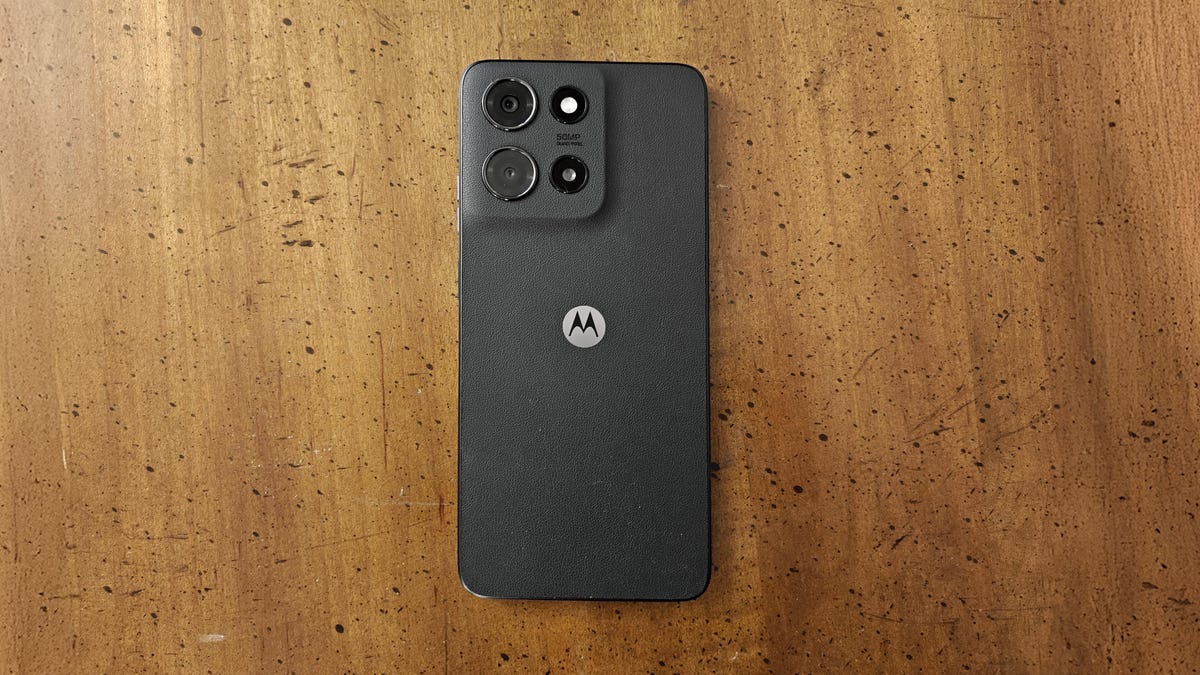
The Moto G (2025). Mike Sorrentino/Zooey Liao/CNET
Over a long weekend of hands-on time with the new $200 Moto G, the latest addition to Motorola's affordable phone lineup drove me totally nuts. The phone frequently crashed when running apps, paused when scrolling through websites and even completely rebooted itself during my late night YouTube watching.
When I review cheaper phones, especially those that cost under $200, it's common and expected for them to have slower performance than more expensive handsets. But when essential and basic functions like opening my web browser or tapping a video become a challenge, my patience for a phone's slower processor usually runs out.
But the Moto G does have a setting you can toggle that improves some of these performance issues, and the phone's cameras can take decent daylight photos. This makes the Moto G a phone that can fulfill most everyday tasks, especially if you find the device at an even-lower price since Motorola often puts its phones on sale.
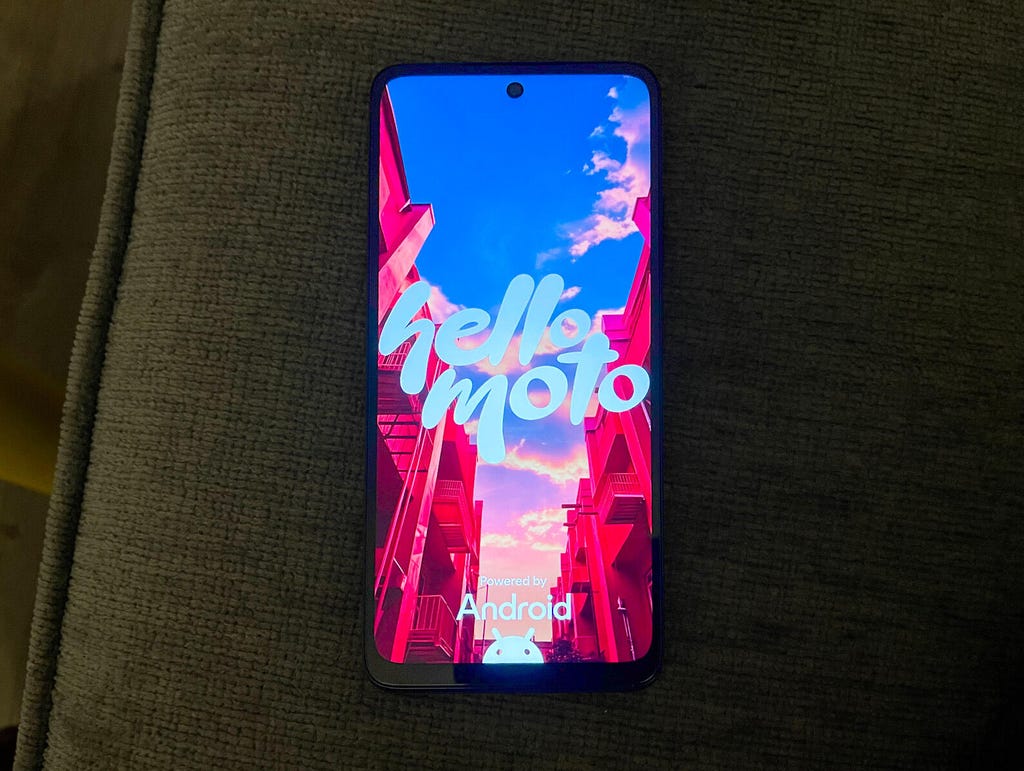
The Moto G rebooted itself while I was sitting on the couch trying to watch YouTube. Mike Sorrentino/Zooey Liao/ CNET
Moto G (2025) performance, RAM boost, features
The Moto G does have a software feature that turns the phone from unbearably slow into a handset that's more capable of running various apps and games. The RAM Boost feature -- which was available on last year's Moto G 5G -- initially defaults to using AI to dynamically convert a portion of the phone's onboard storage into memory that can help it run additional apps and functions. It sounds nice on paper because, in theory, it should expand and contract its footprint based on the services you personally use. But instead of helping the phone run better, I found it to leave the phone feeling constantly underpowered.
So if you do buy the Moto G, I immediately suggest you turn up the RAM Boost setting to 8GB, which will supplement the onboard 4GB of memory with a more consistent level of virtual memory. After I did that, the more extreme performance issues I experienced largely disappeared. I could load apps quickly enough, watch videos and even play a few rounds of Fall Guys and Fortnite on low graphics settings.
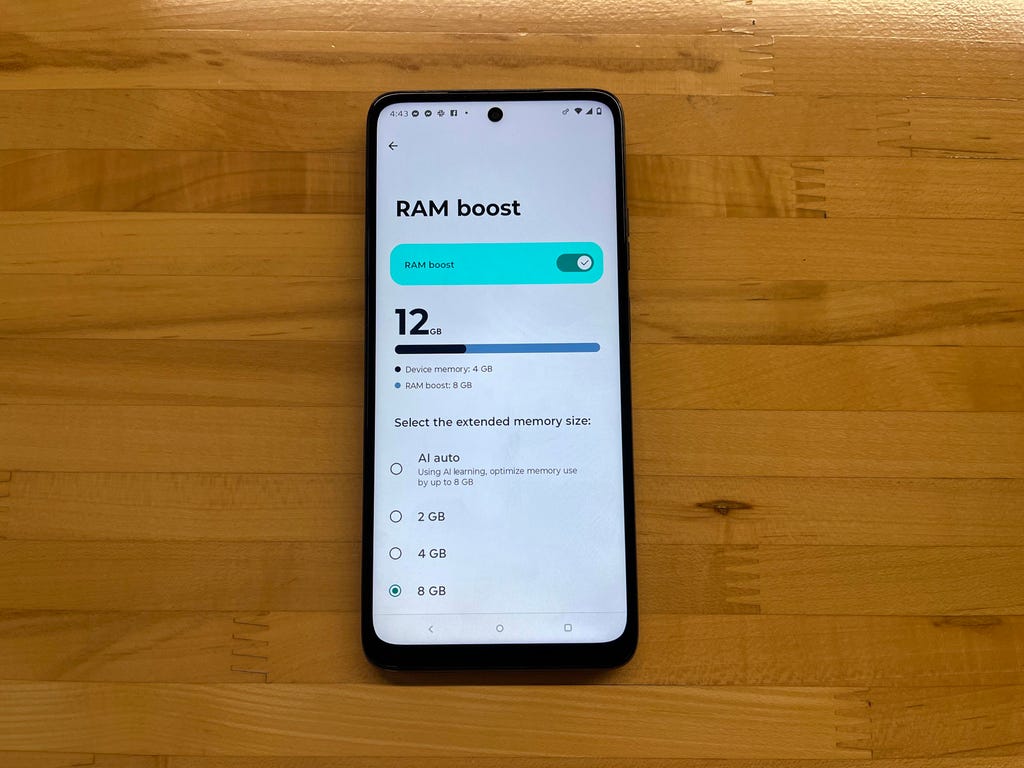
Turn the RAM Boost setting to 8GB to make this phone usable. Mike Sorrentino/CNET
That said, don't expect this phone to suddenly hold its own against more expensive devices. In my benchmark testing using Geekbench 6.0 and 3DMark Wild Life Extreme, the phone's MediaTek Dimensity 6300 turned in performance numbers that are within range of last year's $200 Moto G 5G. Considering my primary complaint when I reviewed that phone was its overall performance, which ran on a Qualcomm Snapdragon 4 Gen 1, it does not feel like this year's Moto G stepped up much year over year.
Performance benchmarks: Moto G (2025) vs. Moto G 5G (2024) vs. Samsung Galaxy A15 5G Geekbench 6.0 3DMark Wild Life Extreme Moto G (2025) Single: 784; Multi: 1,970384; 2.3fpsMoto G 5G (2024) Single: 845 Multi: 1,851297; 1.78 fpsSamsung Galaxy A15 5G Single: 685 Multi: 1,768321; 1.93 fpsThe phone's 4GB of RAM and 128GB of storage are comparable to its rivals, and it does have a microSD card for expandable storage. Its 5,000-mAh battery is fairly large for a phone at this price, and its 6.7-inch LCD display is large but not particularly sharp at 720p resolution.
But there are improvements that do provide a reason for picking up this year's $200 Motorola phone over last year's. The Moto G nearly doubles its wired charging speed to 30 watts, but Motorola does note that only certain carrier editions will include a power adapter in the box this time. And this year's Moto G does retain several of the welcome additions that debuted on last year's Moto G 5G like NFC for contactless payments and its vegan leather design.
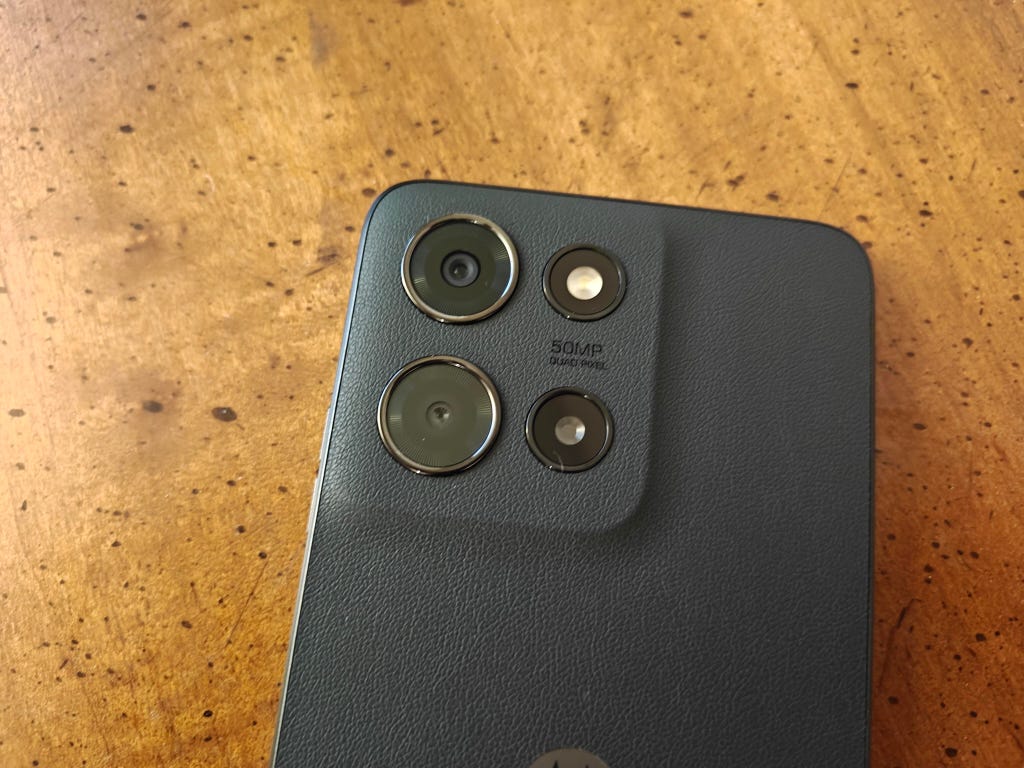
The rear of the Moto G highlights a 50-megapixel wide camera, a 2-megapixel macro camera and a light sensor. Mike Sorrentino/CNET
Moto G (2025) cameras
The Moto G's cameras perform on par with other $200 phones that I typically test, which is to say that photos and videos look OK but have noticeable image noise in many settings. The phone has a 50-megapixel wide camera and a 2-megapixel macro camera. While it may look like the phone has a third camera, that's just a light sensor.
I tested out the phone by taking it to the Gasparilla Pirate Festival in Tampa, Florida, providing a bright, sunny day that allowed for photos that showed off the parade and the costumed attendees. However, most of the shots lack detail when you zoom in even a little to see more of the subjects of the photos.

Photo of the Tampa Fire Department's truck taken by the Moto G's camera. Mike Sorrentino/CNET
For instance, in this photo of the Tampa Fire Department's truck as it drove by within the parade, a quick zoom into most sections of the photo whether it's the truck or the crowd reveals blocky textures. This is especially noticeable if you focus in on the red Yield sign on the right side of the photo.

Photo of attendees at the Gasparilla Pirate Festival, taken on the Moto G. Mike Sorrentino/CNET
In this photo of attendees dressed as pirates, the photos aren't able to quite display much of a difference between the black of the pants of these attendees against the shadows. But much of the other elements of the photo, such as the Tampa General Hospital sign, do show up without much blurring despite being far away.

Photo of myself taken at the Gasparilla Pirate Festival using the Moto G's 16-megapixel selfie camera. Mike Sorrentino/CNET
Using the 16-megapixel selfie camera on the Moto G reminds me of shooting photos with a very simple phone. Thanks to the lighting, the camera does correctly focus in on my face, along with being able to decipher between the black bandana and the strands of my hair. However, everyone else behind me is blurry, making even daylight photos hit or miss in quality.
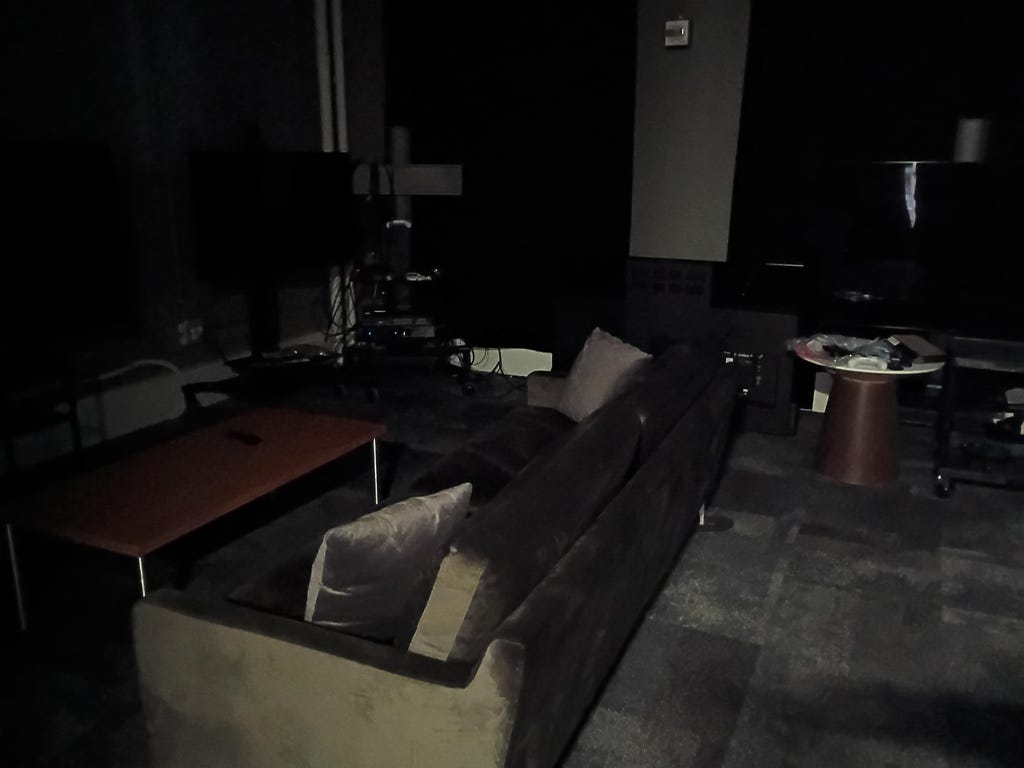
CNET's TV Lab, taken with the Moto G. Mike Sorrentino/CNET
For a more extreme test, I also took the Moto G to CNET's TV lab with blackout curtains, leaving only a small amount of light coming in through a curtain behind me. Considering the cost of the phone, I was actually impressed that it was able to display the small brown table and the couch without devolving into image noise. But the darkness is too much to display any of the televisions. Most night photography won't be this dark, since streetlights and signs may offer some dim environmental lighting, so expect them to be a little brighter than the example above.
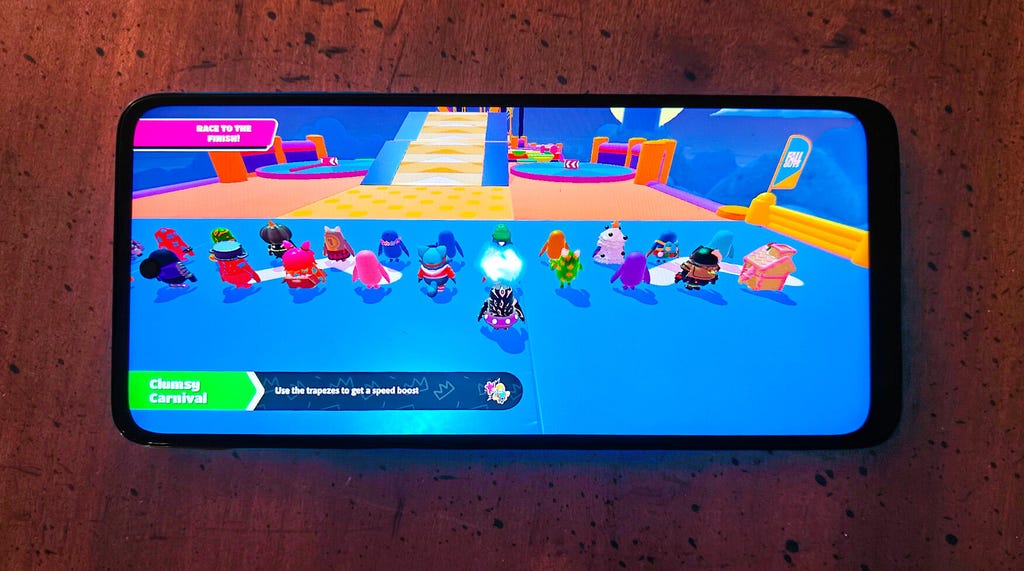
Playing Fall Guys on the Moto G. Mike Sorrentino/Zooey Liao/CNET
Moto G (2025) software and bottom line
This year's Moto G also marks the first time that Motorola is extending its software support promise, committing to two years of updates instead of prior years where it pledged only one additional update. This means that this Moto G ships with Android 15 and should continue to receive major updates until 2027. Unfortunately, its security support has not changed, which remains at three years. This means that anyone buying the phone should likely plan to cycle to a new device by 2028. It's good to see Motorola begin to tick upward on this, but it now lags quite a bit behind the $200 Samsung Galaxy A16 that's set to get six years of software and security support.
However, this year's Moto G does deliver on providing an essentials-only experience, and Motorola's phones are often heavily discounted through either sales by Motorola itself or through carrier promotions. Therefore, if you do need a more basic Android phone and you are able to get it for a lower price, it will be able to run most essential tasks, apps and take simple photos. Just make sure to turn up the RAM Boost immediately to get even basic functionality out of the phone.
Motorola Moto G (2025) vs. Motorola Moto G 5G (2024) vs. Samsung Galaxy A15 5G Moto G 2025Moto G 5G (2024)Samsung Galaxy A15 5G Display size, resolution 6.7-inch LCD; 1,604x720 pixels; 120Hz refresh rate6.6-inch LCD; 1,612 x 720 pixels, 120Hz refresh rate6.5-inch FHD Plus Super AMOLED; 2,340 x 1,080 pixels; 90Hz refresh ratePixel density 263ppi269 ppi420 ppiDimensions (inches) 6.57x3x0.32 in.6.5 x 3 x 0.3 in.6.3 x 3.02 x 0.33 in.Dimensions (millimeters) 167.05x76.3x8.16mm164.4 x 75 x 8.2mm160 x 76.7 x 8.4 mmWeight (ounces, grams) 193g194g201g (7.09 oz.)Mobile software Android 15Android 14Android 14Camera 50-megapixel (wide), 2-megapixel (macro)50-megapixel (wide), 2-megapixel (macro)50-megapixel (wide), 5-megapixel (ultrawide), 2-megapixel (macro)Front-facing camera 16-megapixel8-megapixel13-megapixelVideo capture 720p at 30fpsFHD, 30fps1,080p at 30 fpsProcessor MediaTek Dimensity 6300Qualcomm Snapdragon 4 Gen 1Mediatek Dimensity 6100 PlusRAM/Storage 4GB + 128GB4GB + 128GB4GB RAM + 128GBExpandable storage Yes, microSDYes, microSDYes, microSDBattery/Charger 5,000mAh5,000 mAh5,000 mAhFingerprint sensor SideSideSideConnector USB-CUSB-CUSB-CHeadphone jack YesYesYesSpecial features 30W wired charging, water-repellent design (IP52), Bluetooth 5.3, NFC, 2 years of software updates, 3 years of security updates, Moto Gestures, RAM Boost18W wired charging, Dolby Atmos, NFC, water repellent, gesture controls, Moto Secure, RAM Boost25W wired charging, 800-nit brightnessPrice off-contract (USD) $200 (4GB + 128GB)$200$200 (128GB)Price (GBP) N/AN/A£169 (128GB)Price (AUD) N/AN/AAU$329 (128GB)
-
 C114 Communication Network
C114 Communication Network -
 Communication Home
Communication Home


